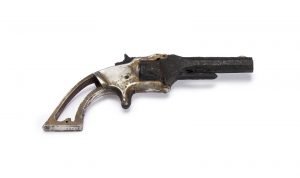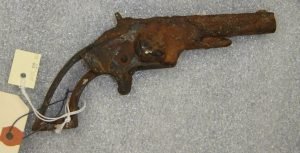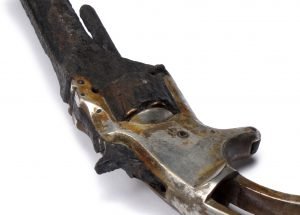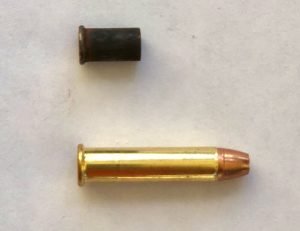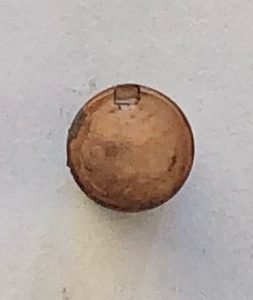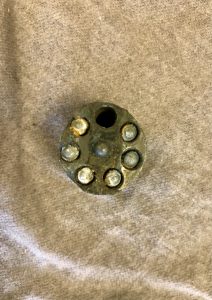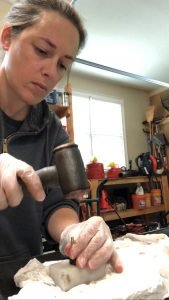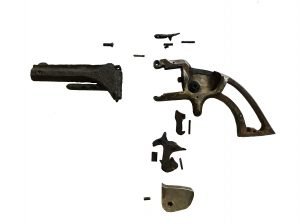On April 4, 1894, the bulk steam freighter Minneapolis sank in the Straits of Mackinac after taking on water due to ice damage. On board the ship was a Smith and Wesson Model No. 1, Second Issue revolver manufactured in 1864. It is a bottom-break revolver that holds seven brass .22 caliber short rimfire cartridges. It was one of the first handguns produced by Smith and Wesson and one of the first to use self-contained brass cartridges. The revolver belonged to one of the 14 crewmembers aboard the ship who may have carried it for numerous reasons.
Firearms were not uncommon amongst Great Lakes sailors. Revolvers provided a form of protection against unwelcome guests aboard a ship and assisted in protection of valuable cargo. Pursers aboard passenger ships were known to carry weapons to protect items entrusted to them by their guests. Officers carried them to protect monies carried on board for payroll and other business. In an emergency, firearms could be used to keep order and act as a signaling device to attract the attention of other vessels and searchers.
The crew of the Minneapolis survived the wreck, being picked up by the San Diego, a consort barge the ship was towing along with the Red Wing. The wreck was located in 1963 and today is approximately 500 feet from the South Tower of the Mackinac Bridge. The revolver was recovered from the shipwreck prior to the 1983 creation of the Straits of Mackinac Underwater Preserve, which makes it illegal to remove items from shipwrecks today. Along with several other objects, the revolver was donated to the Mackinac Island State Park Commission in 2013.
Conservation work was done in the winter of 2014 by Inland Seas Institute (ISI) for inclusion of the revolver in the new Straits of Mackinac Shipwreck Museum. The revolver was placed into electrolysis, which is the process of using electricity, an electrolyte, and anodes to remove corrosion from metal objects. After just a few hours of treatment, it was noticed that the gun still contained cartridges. Treatment of the revolver continued with the awareness that the gun could still contain black powder and lead bullets.
The revolver is composed of a silver-plated brass frame with a steel barrel, cylinder, cylinder rotating mechanisms, screws, springs and pins and brass cartridges with lead bullets which over time interact with one another causing deterioration via bi-metallic corrosion. Even though the revolver was treated, contact between these metals would continue to cause corrosion over time especially during environmental changes. During a cleaning of the exhibits in 2020, recent corrosion was noticed on the revolver. It was removed from display, examined, and photographed. ISI was contacted and a new proposal was developed to treat the corrosion and attempt to disarm the revolver by removing the cartridges and their bullets.
Electrolysis was performed again to halt the corrosion and once stabilized, the revolver was taken to a gunsmith. The cylinder was removed revealing that the gun had 6 loaded cartridges and an empty cartridge under the hammer possibly to act as a safety. Corrosion in the cylinder prevented the gun from being unloaded once the cylinder was removed, so a plan was developed to melt out the lead bullets, remove the powder, and have safe access to the cartridges for their removal. The cylinder was positioned in a way to safely do this in case the powder was still active after 60+ years underwater.
The lead bullets were melted using a propane torch, which upon contact caused three of the cartridges to go off in a controlled manner for safety. The cartridges were then removed using a specially made brass punch. The screws and pins holding the revolver together were removed so complete treatment of each piece could be performed. Upon completion of conservation the revolver parts will be coated with microcrystalline wax prior to reassembly to prevent future corrosion of the barrel, cylinder and cylinder works. The revolver will be reassembled using carbon fiber screws and Delrin (polymer) pins to minimize future bi-metallic corrosion. The cartridges, screws, and pins will be returned and the revolver will be placed back on display inside the shipwreck museum. We hope you’ll join us at Old Mackinac Point in the near future to see the Minneapolis revolver on display once again.






